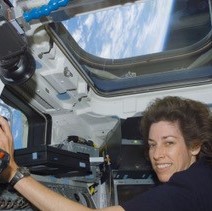Ellen Ochoa
NASA (retired), United StatesFor distinguished service as an astronaut, a technical leader in government, and an optical scientist/engineer.

Ellen Ochoa thought her future was in music or business when she first began her undergraduate studies. However, after enjoying a series of calculus courses, she tried to figure out a career path in math. About halfway through her undergraduate degree at San Diego State University, she turned to physics. She found her class on Fourier transforms most interesting, and when it came time to do her senior year research project, she knew she wanted to conduct research in optics.
Conveniently, San Diego State had just hired a new physics professor working in optics who pointed her to OSA Honorary Member Joe Goodman’s book, Introduction to Fourier Optics. Eventually, Ellen made her way to Stanford for graduate school and ended up working with Joe Goodman. Later, he would serve as one of her primary thesis advisors, along with Bert Hesselink. During Ellen’s time at Stanford, interest in space travel and space research increased due to a new spacecraft, the Space Shuttle. It also coincided with Sally Ride’s space mission. Ride had also studied at Stanford. All of this piqued Ellen’s interest in space.
After graduate school, she applied to NASA’s astronaut program. She was not selected at the time, but she took the interview as a learning experience and went to work for NASA in another capacity. At NASA’s Ames Research Center, her boss served as a mentor as she moved into higher-visibility roles such as Branch Chief. She also got her private pilot’s license. After gaining all of this experience she applied to the astronaut program again and was selected.
Ellen says she “has been fortunate to have an amazing career at NASA.” She worked on the International Space Station (ISS) and was involved before anything was even built. During this process she worked with the Russian Space Agency and went on two missions as part of the ISS assembly. On board, there were numerous opportunities for research. On her first two shuttle flights, Ellen studied Earth’s atmosphere. She credits her background in optics with helping her to feel comfortable during the mission and specifically notes that her optics research was what led her to know how to describe the operation and benefits of the Fourier transform spectrometer on board.
After her space flights, Ellen moved into a variety of management and leadership positions, culminating in serving as Director of Johnson Space Center for 5.5 years. In looking back on what she learned about leadership, she explains that it is important to understand how you can influence and mentor others regardless of your position. She also adds it is vital to listen as well as talk. “Other people have different views, different conclusions—why? Does that change or affect your conclusion?” If you are not listening, you may be missing crucial information.
Ellen says she found it more challenging to be in a management/leadership role than an astronaut because a broader knowledge base is needed as well as soft skills such relationship building, leading people, forming coalitions, and communicating effectively. Ellen advises students and young researchers to take advantage of science or engineering leadership training opportunities even though it can be the farthest thing from your mind when you are caught up in research.
Retired from NASA, today, Ellen is the Vice Chair of the National Science Board, which helps her to understand overall trends in science and research. She believes, “interesting research happens at disciplinary boundaries” and thinks that this will continue to be the case in the future. She also adds that the computing power available today, such as the ability to study large data sets for patterns, will greatly contribute to the research advances. These technological advances also have the ability to engage the public in citizen science which is an opportunity to help people understand the importance of the research being done.
Profile written by Jeanette Gass
